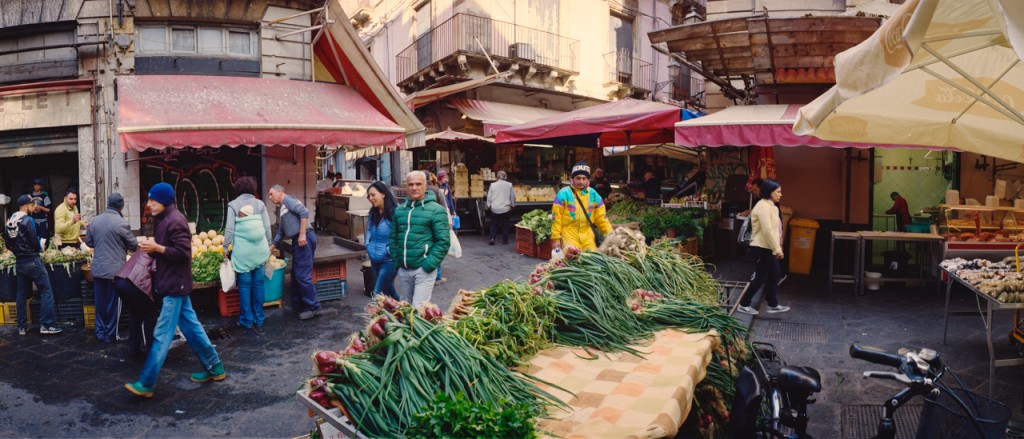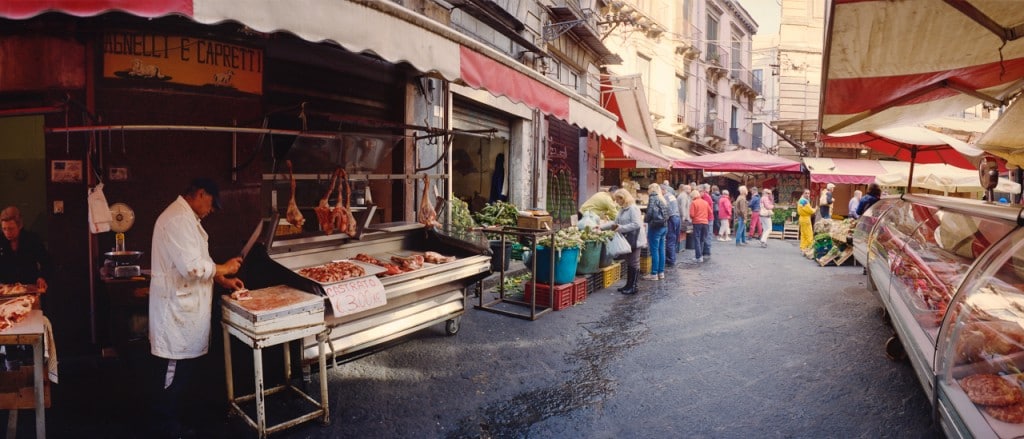Sicily is well known for being a place where theater comes to life— even in everyday living. This can easily be seen at their numerous colorful outdoor markets, a tradition dating back to the 9th century Saracen rule of the island, which explains their striking similarity to Arab souks: the sing song cadence to their words as they call out their wares, and many place names and agricultural terms are Arabic in origin; such as Palermo’s Ballarò market.

The weather helps a lot. Outdoor vendors find a pleasant environment in coastal cities where it hardly ever gets cold enough to snow. That’s not to say that Sicily’s markets will be found only in Palermo and Catania. Almost every town and urban neighborhood has its own extremely well attended mercatino (“little market”) open at least once a week.
One of our favorites, the Ortigia market is in the oldest section of Syracuse, on the tiny island and port where the city of Syracuse was settled almost 3,000 years ago. Open every day except Sunday, it is smaller and more relaxed than the sometimes gritty markets of Palermo, although it is just as busy.

Professional tour guide and local Journey Through Italy friend Gabriel Del Rossi describes his experience at his local market:
“ Hearing the early-morning surf crash against the port in Ortigia, Siracusa (Sarausa in Sicilian dialect) is the perfect prelude for the pending opera. The open-air markets in Sicily are unlike any other in Europe and are are unique to Italy. The earlier you can get to port-side the more magic you get to see: the local fisherman who drift into the bay, half-burnt cigarette clenched between their yellow beards and mustaches. They are not allowed to blow their horns so early in the morning, but they call in the local dialect to their mates on shore. Preparing ropes and nets, their chatter drowns out the hum of the motors.

In the meantime their friends set up the tables in the parking lot of Ortigia. Covering them with with makeshift canvas tents, they prepare styrofoam trays of ice to keep the morning’s catch fresh throughout the day. Mussels, clams of various varieties, shrimp and sea-urchins bring the tables alive as they crawl and flex in the ice. The larger catches of sea bass, cod, and red snapper flip and breathe above water. The immense tunas are brought in by two or more men and cut open on the spot by a fishmonger dressed in rubber. The market by now has come alive with sellers and buyers all who know each other. The vendors yell in Sicilian what they have fresh from the day. And as the next table attempts to out-yell his neighbors, a friendly high-volume banter and joking begins, making the vendors laugh and the buyers smile. Some elderly ladies meet near the squids and octopus to carry on the discussion they had in church the Sunday prior.
If you haven’t made it into a Sicilian household, checkout the fish market in Siracusa–it’s as close to ‘casa’ as you will get.”
But it not only about the fish– the vegetable and fruit vendors know there will be a lot of people at the fish market so a popular venue for their seasonal crops: artichokes in the winter, cucumbers and tomatoes in the summer. The delicious smell of stacks of fresh bread and of peppers and eggplant and onions roasting over open coals is inviting. They also engage in the banter–talking with friends and bartering the prices of produce with the tourists. The locals never barter with the sellers. They know this is their livelihood and the prices are good. In return, the sellers will always add another peach or two after the final weight and price has been determined.

“That’s what is so special about Sicilian markets,” Gabe adds. “It’s community. For thousands of years the Sicilian people have been taking care of each other, and they still do. The market is not just a place to buy food, but also a forum for discussion, to talk about one’s children, or last night’s soccer game against Trapani. “
But one must be prepared for the volume of Sicily’s markets. Vendors call out to customers passing by, describing the merits of what’s fresh and piled on their carts that day, while conversing loudly with their colleagues. Scooters zoom through the narrow aisles, dodging displays. Shoppers stop to chat with neighbors. The atmosphere is lively and noisy, especially in the morning, the best time to shop.
By noon, merchants start to pack up and stalls start to close. And, happily, it will start all over again tomorrow.
Carol Sicbaldi – Tour Leader for Journey Through Italy
As a maestra of authentic tours featuring Italy’s time-honored traditions, the discerning experiences that Carol Sicbaldi shares as a Tour Leader for Journey Through Italy, will push you to explore a life of simple pleasure, uncomplicated flavors, bucolic landscapes and architecture from a time when things were built to last. Take your pick from trekking, authentic home cooked meals, pop-up picnics and wine tastings. She’ll introduce you to artisans whose life’s work is dedicated to keeping their chosen crafts alive, from cheese makers to bakers, honey producers and herbalists. Come celebrate a simplicity long lost in most corners of the world. Slow down, walk, appreciate the rhythm and flavors!














